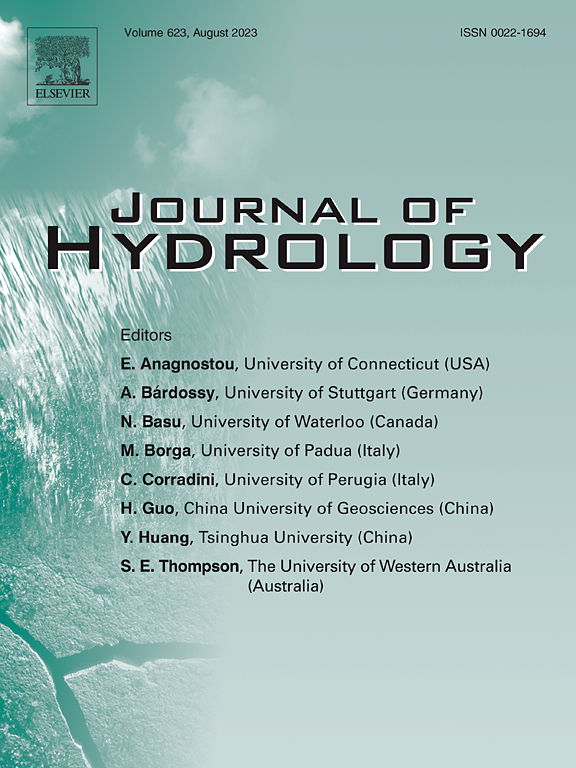High-resolution snow water equivalent estimation derived from downscaled snow depth and non-constant snow density in Chinese Altai Mountains
IF 6.3
1区 地球科学
Q1 ENGINEERING, CIVIL
引用次数: 0
Abstract
Snow water equivalent (SWE) plays a critical role in managing freshwater resources in mountainous areas. Due to the spatial heterogeneity of snow, high-resolution SWE mapping is essential for accurate mountainous snow monitoring. However, the coarse spatial resolution of commonly used SWE datasets introduces uncertainties regarding their accuracy and applicability in these areas. This study combined multi-source remote sensing data fusion downscaling algorithm (MDFDA), Random Forest (RF) model and non-constant snow density (SDE) to reconstruct SWE at 1-km resolution in Chinese Altai mountains (CAM), demonstrating nearly 50 % and 17 % reductions in relative error compared to 25-km reference SWE data and SWE derived from the constant SDE. First, we applied MDFDA to downscale the 25-km passive microwave-derived snow depth (SD) data to 1-km. Next, we input the downscaled SD, along with spatiotemporal and climatological covariates, into RF model to obtain accuracy-optimized downscaled SD (RFSD). Finally, we converted the RFSD to SWE by utilizing two non-constant SDE conversion methods (Power law formula and SDE gridded data). The inclusion of covariates in RF model significantly improved the SD estimation accuracy, with the Pearson correlation coefficient (R) increasing from 0.61 to 0.96. The SWE derived from the Power law formula showed R of 0.85, whereas SDE gridded data yielded improved R of 0.9. Based on reconstructed SWE data, we found statistically significant differences in SWE (p < 0.01) between CMA and non-mountainous areas (NMA) in February and April. Our results are helpful for enhancing high-resolution SD/SWE estimations and hydrological research in mountainous areas.
基于降尺度雪深和非恒定雪密度的阿尔泰山高分辨率雪水当量估算
雪水当量在山区淡水资源管理中起着至关重要的作用。由于积雪的空间异质性,高分辨率SWE制图对于精确监测山区积雪至关重要。然而,常用的SWE数据集的粗糙空间分辨率给它们在这些领域的准确性和适用性带来了不确定性。本研究将多源遥感数据融合降尺度算法(MDFDA)、随机森林(RF)模型和非恒定雪密度(SDE)相结合,在1 km分辨率下重建中国阿尔泰山(CAM)的SWE,与25 km参考SWE数据和由恒定SDE导出的SWE相比,相对误差降低了近50% %和17% %。首先,我们使用MDFDA将25 km被动微波衍生雪深(SD)数据缩小到1 km。接下来,我们将降尺度标准差与时空和气候协变量一起输入到RF模型中,得到精度优化的降尺度标准差(RFSD)。最后,我们利用两种非常数SDE转换方法(幂律公式和SDE网格数据)将RFSD转换为SWE。在RF模型中加入协变量显著提高了SD估计精度,Pearson相关系数(R)由0.61提高到0.96。由幂律公式导出的SWE显示R为0.85,而SDE网格数据的R为0.9。基于重建的SWE数据,我们发现2月和4月CMA与非山区(NMA)的SWE差异有统计学意义(p <; 0.01)。研究结果有助于提高山区高分辨率SD / SWE估算和水文研究水平。
本文章由计算机程序翻译,如有差异,请以英文原文为准。
求助全文
约1分钟内获得全文
求助全文
来源期刊

Journal of Hydrology
地学-地球科学综合
CiteScore
11.00
自引率
12.50%
发文量
1309
审稿时长
7.5 months
期刊介绍:
The Journal of Hydrology publishes original research papers and comprehensive reviews in all the subfields of the hydrological sciences including water based management and policy issues that impact on economics and society. These comprise, but are not limited to the physical, chemical, biogeochemical, stochastic and systems aspects of surface and groundwater hydrology, hydrometeorology and hydrogeology. Relevant topics incorporating the insights and methodologies of disciplines such as climatology, water resource systems, hydraulics, agrohydrology, geomorphology, soil science, instrumentation and remote sensing, civil and environmental engineering are included. Social science perspectives on hydrological problems such as resource and ecological economics, environmental sociology, psychology and behavioural science, management and policy analysis are also invited. Multi-and interdisciplinary analyses of hydrological problems are within scope. The science published in the Journal of Hydrology is relevant to catchment scales rather than exclusively to a local scale or site.
 求助内容:
求助内容: 应助结果提醒方式:
应助结果提醒方式:


